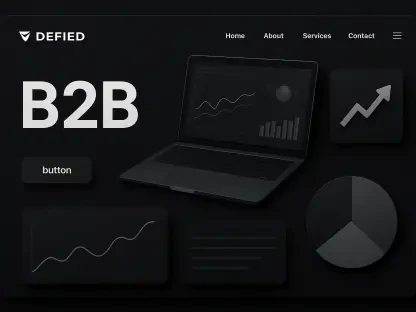The evolution of online advertising has been nothing short of transformative, radically changing the way businesses engage with consumers and revolutionizing the marketing landscape. From the early days of banner ads to the sophisticated programmatic advertising powered by artificial intelligence, online advertising has continually adapted to technological advancements and shifting consumer behaviors. This comprehensive examination delves into the historical milestones and innovations that have shaped the dynamic world of digital advertising, beginning with an overview of its inception and progression over the years.
Introduction to Online Advertising
The advent of the internet revolutionized advertising by offering businesses the unprecedented ability to reach a global audience at a fraction of the cost associated with traditional media. Online advertising leverages digital platforms to communicate messages and promote brands, products, or services, fundamentally altering how businesses engage with their audience. Various forms of online advertising—such as display ads, search engine marketing (SEM), and social media promotions—play crucial roles in the marketing ecosystem.
Traditional advertising methods—television, radio, and print—offered limited targeting capabilities and were often expensive. In contrast, digital mediums present a myriad of channels with unique targeting options, allowing companies to direct their messages to specific audiences. This paradigm shift from traditional to digital advertising has facilitated more precise targeting and provided vivid metrics for evaluating ad performance. This transition significantly influenced consumer behavior, with audiences becoming more accustomed to engaging with online content in personalized and interactive ways.
The internet grants both advertisers and consumers greater agency. Consumers now search for products, read reviews, and consult social media, reflecting an information-driven approach to purchasing. Consequently, brands must adapt their advertising strategies to deliver relevant and timely content. The development of data analytics and consumer insights has refined targeting strategies, making the online advertising landscape more complex yet engaging for both marketers and consumers.
The Birth of Online Advertising: Banners and Early Innovators
The First Banner Ads
The inception of online advertising dates back to the mid-1990s with the introduction of banner ads, which served as precursors to today’s dynamic digital advertising landscape. The first significant banner ad, designed by AT&T and launched in 1994, marked a pivotal moment by demonstrating the potential reach of digital marketing. This pioneering banner ad, with its provocative invitation, “Have you ever clicked your mouse right here? You will,” achieved a remarkable click-through rate of nearly 44%, highlighting the importance of engaging content in capturing audience attention.
Banner ads were initially simple in their design, typically consisting of static images or graphics with minimal text. However, these early advertisements quickly showcased the potential for click-through engagement and lead generation, prompting other companies to explore online advertising opportunities. As businesses began to recognize the value of digital marketing, banner ads evolved to incorporate more creative and visually compelling elements. The success of these early initiatives set the stage for future developments in the rapidly growing online advertising industry.
Early Ad Networks
Early ad networks emerged, with companies like Wired Magazine experimenting to monetize their web traffic through banner placements. These ad networks connected advertisers with website publishers, laying the foundation for the modern advertising ecosystem. As more brands recognized the potential of online marketing, various innovative forms of advertising began to emerge, each with its own unique strategies for reaching consumers in the digital space.
These ad networks facilitated the buying and selling of advertising space, streamlining the process for both advertisers and publishers. By providing a centralized platform for managing ad placements, early ad networks enabled businesses to scale their digital marketing efforts more efficiently. This ecosystem fostered collaboration and innovation, leading to the development of new ad formats and targeting capabilities. Over time, these networks evolved to support more sophisticated technologies, paving the way for advanced advertising techniques that continue to shape the industry today.
Technological Advancements
Technological advancements of the time, particularly HTML and pixel tracking, were crucial in facilitating banner advertising. HTML allowed for integrating visually appealing advertisements on websites, while pixel tracking enabled advertisers to measure campaign performance accurately. This foundational technology spurred the growth of the online ad industry, fostering a competitive landscape that constantly sought to improve ad efficacy and build better marketing strategies for future developments.
The rise of JavaScript and Flash further enhanced the capabilities of online advertisements, enabling more dynamic and interactive ad experiences. Animated banners and interactive elements became increasingly popular, attracting greater user engagement and driving higher click-through rates. As technology continued to evolve, online ads became more sophisticated, incorporating advanced tracking methods and analytics tools to provide deeper insights into campaign performance and user behavior.
The Rise of Search Engine Marketing
Emergence of SEM
As the internet continued to evolve, search engine marketing (SEM) solidified its position as a dominant force in online advertising. SEM encompasses the promotion of websites by increasing their visibility on search engine results pages (SERPs) through paid advertising and optimization tactics. The emergence of powerful search engines, especially Google, revolutionized how advertisers reached their target audience, enabling them to place ads directly in front of users actively seeking specific products or services.
SEM quickly gained traction due to its ability to connect users with highly relevant content during their search journey. By targeting keywords that potential customers were searching for, businesses could drive more qualified traffic to their websites. This increased the likelihood of conversions and underscored the importance of understanding consumer intent within the marketing strategy. SEM also offered robust performance tracking, enabling advertisers to analyze campaign data and refine their strategies over time for better results.
Pay-Per-Click Advertising
The introduction of pay-per-click (PPC) advertising allowed brands to bid on key search terms that resonated with their target consumer audience. This model reduced advertising waste by ensuring that advertisers only paid when users clicked on their ads, making advertising more accessible to small businesses. SEO strategies complemented PPC efforts, enabling companies to improve their organic rankings and maximize their visibility on search engines without incurring additional costs.
PPC advertising democratized digital marketing by providing a cost-effective solution for businesses of all sizes. Unlike traditional advertising methods, where costs were incurred regardless of outcome, PPC’s performance-based pricing model allowed for greater budget control and transparency. Advertisers could set daily spending limits and adjust their bids based on real-time data, optimizing their campaigns for maximum returns on investment. This flexibility and measurable impact made PPC a cornerstone of modern digital marketing strategies.
Google AdWords
Google’s launch of AdWords (now Google Ads) was a game-changer in SEM. By leveraging a sophisticated algorithm to match search queries with relevant ads, Google provided a platform where advertisers could reach their ideal audiences more efficiently. Over the years, Google Ads has evolved, introducing features such as ad extensions and location targeting, further enhancing campaign performance. SEM redefined marketing strategies, emphasizing the importance of data-driven decision-making and continuous optimization to stay competitive in the digital landscape.
The introduction of Quality Score, a metric used by Google to evaluate the relevance and quality of ads, significantly impacted SEM strategies. By prioritizing user experience, Google encouraged advertisers to create highly relevant and high-quality ads, thereby improving the overall search ecosystem. Additional features like ad customization, audience targeting, and retargeting have allowed businesses to connect with potential customers in more meaningful and personalized ways, transforming search engine marketing into an indispensable tool for modern marketers.
Display Advertising: Rich Media and the Emergence of Retargeting
Evolution of Display Advertising
Following the initial success of banner ads, display advertising evolved to encompass more sophisticated formats, including rich media, which integrates video and interactive elements. These advancements allowed advertisers to create more engaging experiences, moving beyond static visuals to harness multimedia storytelling. Rich media ads capture consumer attention more effectively, driving higher engagement rates and increasing brand awareness, thereby reshaping the advertising landscape.
Rich media ads offer users a more interactive and immersive experience, allowing them to engage with content in creative and innovative ways. Advertisers could incorporate videos, animations, and interactive features to create eye-catching advertisements that encouraged user interaction. This shift from static to dynamic ad content aligned with the growing consumer demand for personalized and engaging experiences. As a result, brands could communicate their message more compellingly, fostering deeper connections with their audience and driving higher conversion rates.
The Impact of Retargeting
Retargeting emerged as a powerful strategy in response to changing consumer behavior. By using tracking cookies, advertisers could target users who had previously visited their sites but did not convert, creating opportunities to re-engage potential customers. Retargeting campaigns personalize ad experiences, displaying tailored ads based on users’ past interactions and significantly boosting conversion rates. This technique exemplifies the shift toward more precise targeting and data utilization in digital advertising, emphasizing the importance of personal connections between brands and consumers.
The effectiveness of retargeting lies in its ability to keep brands top-of-mind for consumers who may be undecided or in the research phase of their purchasing journey. By serving relevant ads to these users as they navigate the web, retargeting helps guide potential customers back to the advertiser’s site, increasing the likelihood of conversion. The development of sophisticated tracking and segmentation tools enhanced the efficacy of retargeting campaigns, allowing advertisers to deliver more targeted and relevant messages to different audience segments based on their behavior and preferences.
Programmatic Advertising: Automation and Artificial Intelligence
Programmatic Advertising Platforms
The rise of programmatic advertising represents the latest advancement in online advertising. Programmatic advertising utilizes automation and artificial intelligence to facilitate real-time bidding and targeted ad placements, significantly enhancing the efficiency and effectiveness of digital campaigns. This automated approach leverages data analytics, consumer behavior insights, and machine learning algorithms to deliver highly personalized and relevant ads to specific audiences.
Programmatic advertising platforms enable advertisers to purchase ad space in real-time across multiple channels, including websites, apps, and social media. This level of automation streamlines the ad buying process, allowing for precise audience targeting and optimal resource allocation. By using advanced algorithms, programmatic advertising can analyze vast amounts of data to make real-time decisions, ensuring that ads are shown to the most relevant consumers at the right time. This evolution has redefined the advertising landscape, making it more data-driven and results-focused.
The Role of Artificial Intelligence
Artificial intelligence plays a crucial role in the success of programmatic advertising by processing large volumes of data to optimize ad placements and targeting strategies. Machine learning algorithms can predict consumer behavior patterns, allowing advertisers to deliver more relevant ads based on user interests, demographics, and online activities. This level of automation and intelligence reduces the manual labor involved in campaign management and enhances overall campaign performance.
The integration of AI in programmatic advertising also enables dynamic ad creation, where ad content is personalized in real-time based on individual user profiles. This capability ensures that each user receives a tailored ad experience, increasing engagement levels and conversion rates. Moreover, AI-driven analytics provide advertisers with deep insights into campaign performance, allowing for continuous optimization and improvement. This emphasis on data-driven decision-making and automation marks a significant shift in the advertising industry, highlighting the growing importance of innovation and technological advancements.
Conclusion
The evolution of online advertising has been nothing short of transformative, dramatically changing how businesses interact with consumers and completely overhauling the marketing landscape. From humble beginnings with simple banner ads to today’s complex programmatic advertising driven by artificial intelligence, online advertising has continually evolved alongside technological advancements and changing consumer behaviors.
This thorough analysis explores the key milestones and innovations that have shaped the ever-changing world of digital advertising. Starting with a review of its inception, it traces the significant events and technological innovations that have defined its growth and adaptation over the years.
Early online ads were basic and limited in their capabilities, but they laid the groundwork for more innovative techniques. As technology progressed, so did the methods of advertising, becoming more targeted and data-driven. The integration of AI and machine learning has allowed for highly personalized advertising campaigns, enabling businesses to reach consumers with unprecedented precision and effectiveness.
The journey of online advertising is marked by continual adaptation and improvement. It’s a story of leveraging new technologies to meet the evolving demands of consumers, ensuring that businesses can engage more effectively and efficiently. This exploration highlights the dynamic nature of digital advertising and its pivotal role in modern marketing strategies.









